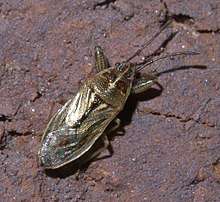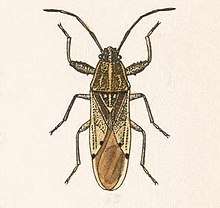Pachygronthidae
| Pachygronthidae | |
|---|---|
 | |
| Oedancala dorsalis | |
| Scientific classification | |
| Kingdom: | Animalia |
| Clade: | Euarthropoda |
| Class: | Insecta |
| Order: | Hemiptera |
| Superfamily: | Lygaeoidea |
| Family: | Pachygronthidae Stål, 1865 |
Pachygronthidae is a family of true bugs in the order Hemiptera. There are about 14 genera and at least 80 described species in Pachygronthidae.[1][2][3][4]

Pachygrontha oedancalodes
Genera
These 14 genera belong to the family Pachygronthidae:
Data sources: i = ITIS,[1] c = Catalogue of Life,[2] g = GBIF,[3] b = Bugguide.net[4]
References
- 1 2 "Pachygronthidae Report". Integrated Taxonomic Information System. Retrieved 2018-04-26.
- 1 2 "Browse Pachygronthidae". Catalogue of Life. Retrieved 2018-04-26.
- 1 2 "Pachygronthidae". GBIF. Retrieved 2018-04-26.
- 1 2 "Pachygronthidae Family Information". BugGuide.net. Retrieved 2018-04-26.
Further reading
- Arnett, Ross H. Jr. (2000). American Insects: A Handbook of the Insects of America North of Mexico (2nd ed.). CRC Press. ISBN 0-8493-0212-9.
- Bantock, T.; Botting, J. (2013). "British Bugs, an online identification guide to UK Hemiptera". Retrieved 2018-04-26.
- Blatchley, W.S. (1926). Heteroptera, or true bugs of eastern North America, with especial reference to the faunas of Indiana and Florida. Nature Publishing. doi:10.5962/bhl.title.6871.
- Borror, Donald J.; Peterson, Roger Tory; White, Richard E. (1998). A Field Guide to Insects. Houghton Mifflin. ISBN 978-0395911709.
- Gillott, Cedric (1980). Entomology. Plenum Press. ISBN 0-306-40366-8.
- Henry, Thomas J. (1997). "Phylogenetic Analysis of Family Groups within the Infraorder Pentatomomorpha (Hemiptera: Heteroptera), with Emphasis on the Lygaeoidea". Annals of the Entomological Society of America. 90 (3): 275–301. ISSN 0013-8746.
- Henry, T.J. (2009). "Biodiversity of the Heteroptera". In: Foottit R.G., Adler P.H., eds. Insect biodiversity: Science and society. Oxford: Wiley-Blackwell: 223-263.
- Henry, Thomas J. (2009). Foottit, Robert G.; Adler, Peter H., eds. Chapter 10. Biodiversity of Heteroptera. Insect Biodiversity: Science and Society. Blackwell Publishing (Wiley-Blackwell). pp. 223–263. ISBN 9781405151429.
- Henry, Thomas J.; Froeschner, Richard C., eds. (1988). Catalog of the Heteroptera, or True Bugs, of Canada and the Continental United States. E. J. Brill. ISBN 0-916846-44-X.
- Kellogg, Vernon L. (1905). American insects. H. Holt.
- Majka, C. (2009). "Thomas L. Casey and Rhode Island". ZooKeys. 22. doi:10.3897/zookeys.22.93.
- Misof, B.; Liu, S.; Meusemann, K.; Peters, R.S.; et al. (2014). "Phylogenomics resolves the timing and pattern of insect evolution". Science. 346 (6210): 763. doi:10.1126/science.1257570.
- Walker, Francis (1871). Catalogue of the Specimens of Hemiptera Heteroptera in the Collection of the British Museum, pt. IV. British Museum. doi:10.5962/bhl.title.9254.
External links

This article is issued from
Wikipedia.
The text is licensed under Creative Commons - Attribution - Sharealike.
Additional terms may apply for the media files.